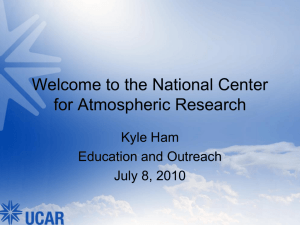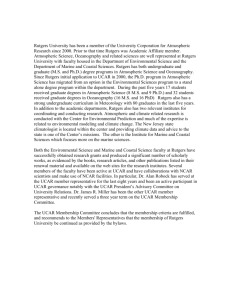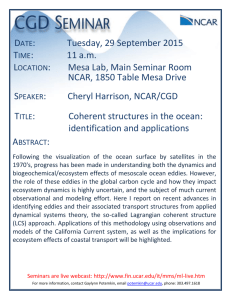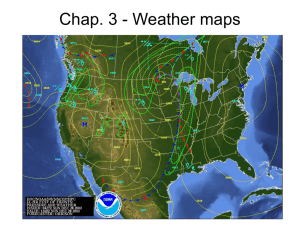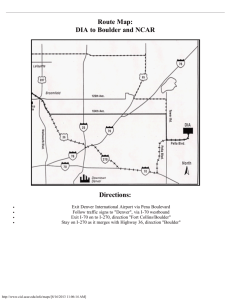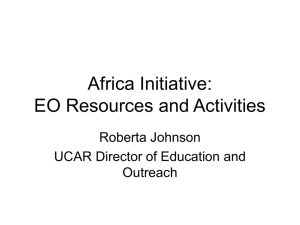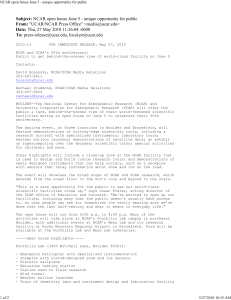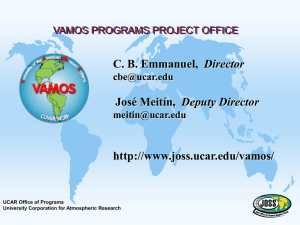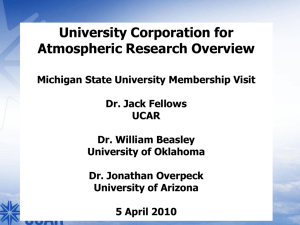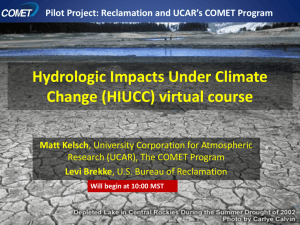Board of Trustees Rick Anthes June 12, 2001
advertisement
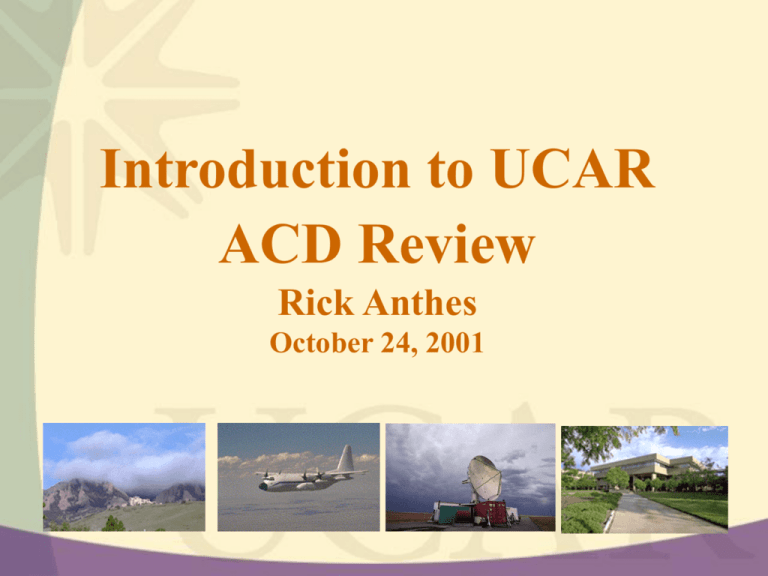
Introduction to UCAR ACD Review Rick Anthes October 24, 2001 UCAR a non-profit corporation formed in 1959 to serve the atmospheric and related science and education community The UCAR mission to support, enhance, and extend the capabilities of the university community, nationally and internationally; to understand the behavior of the atmosphere and related systems and the global environment; and to foster the transfer of knowledge and technology for the betterment of life on earth. UCAR Governance • Membership: 66 member North American universities with appropriate doctorate program; 20 Academic Affiliates • Governance: 132 Member Representatives and Board of Trustees • Guidance: advisory committees and review panels and significant university involvement in every UCAR program • Peer Review: NSF 3-5 year review process. UCAR Members University of Alabama in Huntsville University of Alaska University at Albany, State University of New York University of Arizona Arizona State University California Institute of Technology University of California, Davis University of California, Irvine University of California, Los Angeles University of Chicago Colorado State University University of Colorado at Boulder Cornell University University of Denver Drexel University Florida State University Georgia Institute of Technology Harvard University University of Hawaii Howard University University of Illinois at Urbana-Champaign University of Iowa Iowa State University The Johns Hopkins University University of Maryland Massachusetts Institute of Technology McGill University University of Texas at Austin University of Miami Texas Tech University University of Michigan-Ann Arbor University of Toronto University of Minnesota Utah State University University of Missouri University of Utah Naval Postgraduate School University of Virginia University of Nebraska, Lincoln University of Washington University and Community College Washington State University System of Nevada University of Wisconsin- Madison University of New Hampshire, Durham University of Wisconsin-Milwaukee New Mexico Institute of Woods Hole Oceanographic Mining and Technology Institution New York University University of Wyoming North Carolina State University Yale University The Ohio State University York University University of Oklahoma Old Dominion University Oregon State University Pennsylvania State University Princeton University Purdue University University of Rhode Island Rice University Rutgers University Saint Louis University Scripps Institution of Oceanography at UCSD Stanford University Texas A & M University UCAR’s Six Goal Areas • Science--foster a broad scientific program of highest quality to address present and future needs of society • Research facilities--develop and acquire state-of-the-art scientific research facilities • Education and training--devote significant attention to education and training, with emphasis on women and minorities • Advocacy, public policy, and communication--in cooperation with other institutions, play a strong role in developing enhanced and more effective methods of communication among scientists, policymakers, and the public in order to foster the use of science in the service of humankind • Technology transfer--in conjunction with the UCAR Foundation, transfer appropriate UCAR technology to the public and private sectors • Research and operational partnerships--strengthen the relationship between the operational and research communities University Corporation for Atmospheric Research Member Institutions Board of Trustees Finance & Administration President Corporate Affairs Katy Schmoll, VP Richard Anthes Jack Fellows, VP Tim Killeen, Director UCAR Programs Steve Dickson, Associate Director Jack Fellows, Director NCAR Information Infrastructure Technology & Applications (IITA) Richard Chinman Atmospheric Chemistry Division (ACD) Atmospheric Technology Division (ATD) David Carlson Daniel McKenna Environmental & Societal Impacts Group (ESIG) Robert Harriss Advanced Study Program (ASP) High Altitude Observatory (HAO) Michael Knölker Climate & Global Dynamics Division (CGD) Al Cooper Mesoscale & Microscale Meteorological Division (MMM) Robert Gall Maurice Blackmon Research Applications Programs (RAP) Scientific Computing Division (SCD) Brant Foote Al Kellie Cooperative Program for Optional Meteorology Education and Training (COMET) Constellation Observing System for Meteorology Ionosphere Climate (COSMIC) Timothy Spangler GPS Science and Technology Program (GST) Randolph Ware Bill Kuo Digital Library for Earth System Science (DLESE) Mary Marlino Unidata Visiting Scientists Programs (VSP) Joint Office for Science Support (JOSS) David Fulker Meg Austin Karyn Sawyer Denotes President’s Office 12/07/98 UCAR Board of Trustees Otis Brown, University of Miami, Chairman Richard Anthes, UCAR President Leo Donner, Princeton Univ., Vice Chairman & Personnel Comm Chairman Kelvin Droegemeier, University of Oklahoma Eugenia Kalnay, University of Maryland Charles Kennel, Scripps Institution of Oceanography Ron McPherson, American Meteorological Society Neal Lane, Rice University Mary Jo Richardson, Texas A&M University Paola Rizzoli, Massachusetts Institute of Technology Soroosh Sorooshian, University of Arizona David Skaggs, Center for Democracy and Citizenship Ronald Smith, Yale University Orlando Taylor, Howard University Gabor Vali, University of Wyoming Patricia Woodworth, Univ. of Chicago, Audit and Finance Comm Chairwoman UCAR Service to Community • Facilities – – – – Computing (SCD) Visualization Laboratory Mass Store (for data sets) Observational facilities (ATD) • Community Models and Software – – – – Community Climate System Model (CCSM) MOZART MM5 and Weather Research and Forecast model-WRF Whole Atmosphere Community Climate Model (WACCM) – Earth System Model Framework • Support of field programs (ATD, Joint Office of Science Support) Service to Community • Educational materials (e.g. COMET) • Community data sets – Research (observations, analysis, models) – Real time to universities (UNIDATA) • Collaborative research, visiting appointments, workshops • Advocacy of atmospheric sciences with Administration and Congress – Action Alerts to community – Written and oral testimonies Planning and Priority Setting • Occurs through a variety of mechanisms and processes – External committees, panels, and studies (e.g. NRC reports) – UCAR Governance (Members, Trustees, divisional advisory committees) – NSF committees and guidance – Internal committees (NCAR Directors Committee, President’s Council, other UCAR committees) – Consulting with community (e.g. surveys) Planning and Priority Setting • Almost all NCAR and UCAR scientists, engineers and management are very active in national and international planning activities, and are well informed of the discussions and recommendations coming from these community planning activities Planning and Priority Setting • Input from all of the above is considered. • The good judgment of management and the scientists themselves are used to establish priorities according to a number of criteria. Criteria used in priority setting • Quality • Relevance to UCAR and NCAR missions and strategic plans • University involvement and service • Relevance to NSF priorities • For non-NSF programs, relevance to the sponsor’s mission and fit with NSF program Criteria, continued • • • • • National and international priorities Readiness Opportunity (availability of resources) Initiative/intuition of individual scientists Development of human resources, including diversity • Maintain programmatic balance Program balances to consider • • • • • • • Theory, modeling and observations Instrument use and instrument development “Facilities” and “science” Individual initiative/freedom and team efforts Community service and “in-house” science Leadership and support Breadth and depth Thank you!
